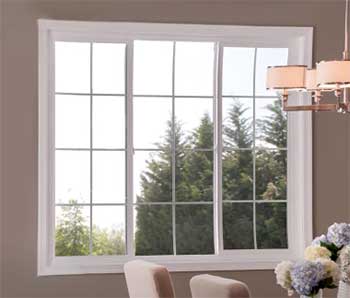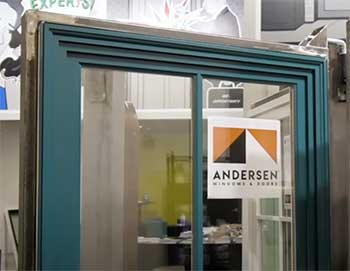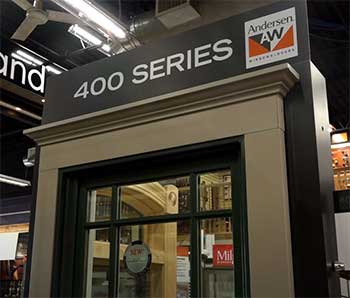When it comes time to replace the windows in your home, you’ll likely come across two big brand names: MI Windows and Andersen Windows. Both companies have been around for decades and offer a wide selection of high-quality windows to choose from.
But how do you decide which is the better choice for your home and budget?
In this comprehensive guide, we’ll compare the pros, cons, features and prices of MI and Andersen windows to help you make an informed decision. Whether you’re looking for the most energy efficient windows or the most budget-friendly option, we’ve got you covered.
A Brief Comparison Table
| Feature | MI Windows | Andersen Windows |
| Frame Materials | Vinyl, aluminum-clad wood | Fibrex composite, wood |
| Glass Options | Double pane standard, some triple pane available | Double and triple pane available |
| Weatherstripping | Dual-fin SealSecureTM | FlexiSeal® interlocking fins |
| Warranty | Lifetime on glass, 10 years parts, 1 year labor | 20 years comprehensive coverage |
| Smart Home Options | Next Gen SmartHome system | VeriLock® Security sensors |
| Cost | Very affordable, 40-50% less than Andersen | Expensive premium products |
| Styles | Traditional double-hungs, sliders, casements | Contemporary, innovative window styles |
| Reputation | Known for budget-friendly price/quality | Industry leader, luxury brand name |
| Energy Efficiency | Meet or exceed ENERGY STAR standards | Superior efficiency with triple pane glass |
| Customization | Wide range of add-ons available | More limited exterior color options |
MI Windows Overview
MI Windows, which stands for “Modern Innovations” Windows, is based in Maryland and has been manufacturing windows since the 1960s. They offer a full line of replacement windows including single-hung, double-hung, sliding, casement, awning, bay and bow windows.
Pros of MI Windows:

- Budget-friendly pricing. MI windows are very competitively priced without sacrificing quality.
- Good variety of styles. From traditional double-hungs to contemporary casements, MI has plenty of options to match your home’s aesthetic.
- Solid warranties. Most MI windows come with a limited lifetime warranty on glass, a 10-year warranty on components and a 1-year installation warranty.
- Energy efficient. MI’s double pane windows with Low-E glass qualify for ENERGY STAR ratings in all climate zones.
- Customizable options. MI allows you to customize your windows with add-ons like tinted glass, obscure glass, patterned glass and more.
Cons of MI Windows:
- Not as many high-end options. MI doesn’t offer triple pane glass or other ultra high-end features.
- Limited national presence. Primarily serves mid-Atlantic region with some nationwide availability.
- Shorter track record. MI has been around for decades but doesn’t have a 100+ year legacy like some brands.
Andersen Windows Overview
Andersen Windows, headquartered in Minnesota, is one of the oldest and largest window manufacturers in the U.S. They’ve been making windows since 1903 and are known for their high-quality craftsmanship and cutting edge designs.
Pros of Andersen Windows:

- Industry leading reputation. Andersen is practically synonymous with windows and respected for their innovation.
- Broad product range. Everything from double-hungs, awnings and bays to unique tilt-wash options, truck windows and more. Also offer door systems.
- Superior craftsmanship. Andersen windows feature mortise and tenon joinery, heavy-duty hardware and exceptional care in manufacturing.
- Leading energy efficiency. Triple pane glass, thermally optimized frame materials and proprietary weatherstripping provide superior thermal performance.
- Sleek contemporary styles. Many exclusive Andersen window designs feature clean lines and modern aesthetics.
Cons of Andersen Windows:
- Very expensive. Among the priciest window options, sometimes 2-3x the cost of other brands.
- Limited exterior color options. Most Andersen windows only come in white or sandtone exterior.
- Mostly vinyl framing. No wood interior options like some other high-end brands offer.
- Large importer. Andersen outsources some window production overseas.
- Questionable sales process. Aggressive sales tactics turn off some homeowners.
Key Differences Between MI Windows And Andersen Windows
Now that we’ve compared the pros and cons of the two brands, let’s look at some of the most important window features and see how Andersen and MI stack up.
Frame Materials

The frame material affects a window’s durability, energy efficiency, aesthetics and cost.
MI Windows offers vinyl and aluminum-clad wood frames. Their vinyl frames feature heavy-duty PVC construction with insulating air chambers.
The aluminum-clad wood frames have a pine interior wrapped in a thick, dent-resistant aluminum exterior.
Andersen makes windows primarily with Fibrex composite material, which consists of wood fiber and thermoplastic polymers. Fibrex is strong, low-maintenance and thermally resistant.
Andersen still offers some solid wood windows as well.
For most homes, MI’s vinyl and Andersen’s Fibrex offer the best blend of durability, energy efficiency and affordability. Wood frames are beautiful but require more maintenance.
Glass Types
Another vital window feature is the type of glass used. Options include:
- Single pane – One layer of glass. Poor insulation.
- Double pane – Two layers of glass with a sealed air space in between. Better insulation than single pane.
- Triple pane – Three layers of glass for optimal thermal performance. Significantly more expensive.
Both MI and Andersen use double pane glass in their standard window units. For maximum energy efficiency, Andersen’s triple pane High-PerformanceTM glass is unbeatable but costs much more.
Double pane glass with Low-E coatings or argon gas fill sufficiently meets the needs of many homeowners on a budget.
Weatherstripping
Quality weatherstripping is what seals out drafts, moisture and noise. Both brands offer weatherstripping made from vinyl, foam and other materials.
Andersen uses their patented FlexiSeal® weatherstrip system featuring dual foam seals and flexible fins that interlock when the window closes. It’s engineered for superior sealing and durability.
MI’s double-fin SealSecureTM weatherstripping with flexible TPE and rigid finsalso does an excellent job sealing the window sash and frame.
Overall, both companies offer weatherstripping technology sufficient for most climates. Andersen may have a slight performance edge but average users likely won’t notice a significant difference.
Warranties

It’s important to consider the warranties that stand behind new windows.
MI Windows come with a limited lifetime warranty on glass, a 10-year warranty on mechanical parts and screen materials, and a 1-year limited warranty on labor.
All warranties are transferable.
Andersen supports their products with a 20-year limited warranty covering the glass panel, Fibrex materials and hardware.
Non-glass parts have a 10-year coverage and exterior aluminum cladding finishes are warranted for 10 years as well.
For most homeowners, MI’s lifetime glass coverage provides sufficient reassurance alongside their 1-year labor warranty. Andersen’s longer 20-year comprehensive warranty on glass and Fibrex materials reflects their products’ quality and longevity.
Smart Home Features
Today’s tech-savvy homeowners may want window systems compatible with home automation and security.
MI’s Next Gen SmartHome System allows electronic windows monitoring, smart home system integration, geofencing security triggers and voice activation via Google Home or Amazon Alexa.
Andersen’s VeriLock® Security monitors sensors that detect window forced entry. When paired with smart home systems like Alexa Guard, it can automatically trigger alarms and alerts.
Both brands offer impressive smart window capabilities for those who desire home automation and security. Andersen’s systems may have a more seamless integration for those already using other Andersen products and software.
Cost Comparison
Of course, cost is a major factor when purchasing new windows.
As MI’s primary value proposition, their windows are 40-50% less expensive than comparable Andersen windows in most cases. Here are some example prices:
- Basic 36″ x 60″ double-hung vinyl MI window: $230 – $300
- Basic 36” x 60” Fibrex Andersen window: $600 – $800
- Large custom 60” x 48” MI bay window with installation: $1000 – $1500
- Large custom 60″ x 48″ Andersen bow window with installation: $3000 – $5000
While not an apples-to-apples comparison, this illustrates the wide gulf in cost between MI and Andersen. Of course, you get what you pay for in terms of materials, efficiency, quality and brand reputation.
For buyers prioritizing affordability and basic functionality, MI is likely the better choice. Homeowners wanting best-in-class performance, aesthetics and prestige will view Andersen as a worthwhile investment.
MI And Andersen Windows: FAQs
Yes, MI windows are very good, quality windows. They use strong vinyl and aluminum-clad wood frames along with insulating double pane glass. Their products meet or exceed ENERGY STAR guidelines for thermal efficiency. MI windows feature robust hardware, weatherstripping and manufacturing. Overall, they offer a durable and well-engineered product at an affordable price point.
Some brands considered comparable to Andersen in terms of quality are Pella, Marvin, Milgard, Simonton, JELD-WEN and Ply Gem. Andersen is in the high-end tier of window manufacturers, so no brand is directly equivalent, but these companies make premium-grade windows with similar construction, efficiency, aesthetics and performance. Those on a budget may also want to consider MI Windows.
No, MI would be considered a step above typical builder grade. Their windows feature heavier-duty vinyl and aluminum clad wood rather than basic vinyl. They also have sturdy hardware, quality weatherstripping and insulated Low-E glass. Since MI doesn’t offer triple pane glass or exotic frame materials, they are not at the absolute top tier, but compete well with mid-level brands. Overall, MI offers windows a cut above basic contractor grade products.
Andersen’s biggest competitor is probably Pella Windows. Both companies are large, longstanding, national window manufacturers known for high quality products. Marvin Windows is another close competitor in the premium window category. JELD-WEN and Milgard also make very nice windows that some may prefer over Andersen’s based on style, cost and other factors. But Pella remains Andersen’s closest rival as far as brand recognition, breadth of product line, innovation and prestige.
Closing Remarks
MI Windows and Andersen are both highly reputable brands that manufacture attractive, energy efficient replacement windows. Which is right for your home depends on your budget, priorities and needs.
Those wanting basic vinyl double-hung windows at a reasonable price will be more than satisfied with MI’s offerings.
Homeowners who want premium features, contemporary styling, smart home integration and prestige should expect to pay accordingly for Andersen’s top-tier windows.
You really can’t go wrong with either brand. Paying attention to each company’s strengths and weaknesses will help you make the optimal selection for your replacement window project and get the best long-term value.

